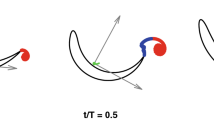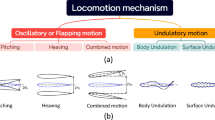Abstract
We present an experimental model to investigate the influence of body flexibility on the fast-start response. The model is fabricated with a variable stiffness, characterized by the direction of applied force. When the fluid force is applied in one direction, the structure acts flexibly and bends, and when the force is applied in the opposite direction, it remains rigid. The structure is rotated from its initial straight position in its flexible direction to a given angle (Stage 1), and then it is rotated back in its rigid direction to an angle in the opposite direction (Stage 2). The wake patterns are studied with bubble image velocimetry (BIV) showing that the main propulsive jet, previously observed in the live fish fast-start, can be produced using this model. Based on our results, we determine that flexibility during Stage 1 and increased rigidity during Stage 2 predict velocity profiles and escape angles consistent with those observed in live fish. A parametric study on the effect of angular velocity and total swept angle on the produced power reveals that the magnitude of swept angle is critical to formation of the propulsive jet. The peak power transfer is found to be more sensitive to increasing the angular velocity for larger swept angles, where a complete jet is already formed.
Graphic abstract













Similar content being viewed by others
References
Ahlborn B, Harper DG, Blake RW, Ahlborn D, Cam M (1991) Fish without footprints. J Theor Biol 148(4):521–533
Ahlborn B, Chapman S, Stafford R, Blake RW, Harper DG (1997) Experimental simulation of the thrust phases of fast-start swimming of fish. J Exp Biol 200:2301–2312
Blake RW (2004) Review paper: fish functional design and swimming performance. J Fish Biol 65:1193–1222
Borazjani I (2013) The functional role of caudal and anal/dorsal fins during the c-start of a bluegill sunfish. J Exp Biol 216:1658–1669
Borazjani I, Sotiropoulos F, Tytell ED, Lauder GV (2012) Hydrodynamics of the bluegill sunfish c-start escape response: three-dimensional simulations and comparison with experimental data. J Exp Biol 215:671–684
Conte J, Modarres-Sadeghi Y, Watts MN, Hover FS, Triantafyllou MS (2010) A fast-starting robotic fish that accelerates at 40 m/s2. Bioinspiration Biomim 5:035004
Domenici PD, Blake RW (1991) The kinematics and performance of the escape response in the angelfish (Pterophyllum eimekei). J Exp Biol 156:187–205
Epps BP, Techet AH (2007) Impulse generated during unsteady maneuvering of swimming fish. Exp Fluids 43:691–700
Flammang BE, Lauder GV (2008) Caudal fin shape modulation and control during acceleration, braking and backing maneuvers in bluegill sunfish, Lepomis macrochirus. J Exp Biol 212(2):277–286. https://doi.org/10.1242/jeb.021360
Freymouth P (1988) Propulsive vortical signature of plunging and pitching airfoils. AIAA J 26:881–883
Gibb AC, Dickson KA, Lauder GV (1999) Tail kinematics of the chub mackerel Scomber japonicus: testing the homocercal tail model of fish propulsion. J Exp Biol 202:2433–2447
Harper DG, Blake RW (1990) Fast-start performance of rainbow trout Salmo gairneri and northern pike Esox lucius. J Exp Biol 150:321–342
Harper DG, Blake RW (1991) Prey capture and the fast-start performance of northern pike, Esox lucius. J Exp Biol 155:175–192
Lauder GV (1982) Structure and function of the caudal skeleton in the pumpkinseed sunfish, Lepomis gibbosus. J Zool Lond 197:483–495
Lauder GV (2000) Function of the caudal fin during locomotion in fishes: kinematics, flow visualization, and evolutionary patterns. Am Zool 40:101–122
Lauder GV, Madden PGA (2007) Fish locomotion: kinematics and hydrodynamics of flexible foil-like fins. Exp Fluids 43:641–653
Lauder GV, Drucker EG, Nauen J, Wilga CD (2003) Experimental hydrodynamics and evolution: caudal fin locomotion in fishes. In: Bels V, Gasc J-P, Casinos A (eds) Vertebrate biomechanics and evolution. Bios Sci. Publ, Oxford, pp 117–135
Li G, Müller UK, van Leeuwen JL, Liu H (2014) Escape trajectories are deflected when fish larvae intercept their own C-start wake. J R Soc Interface 11:20140848
PIVview 2C/3C (2018) User manual, PIVTEC. http://www.pivtec.com. Accessed Dec 2018
Seyed-Aghazadeh B, Carlson DW, Modarres-Sadeghi Y (2017) Vortex-induced vibration and galloping of prisms with triangular cross-sections placed in water flow. J Fluid Mech 817:590–618
Spierts IL, Leeuwen JL (1999) Kinematics and muscle dynamics of C- and S-starts of carp (Cyprinus carpio L.). J Exp Biol 202:393–406
Streitlien K, Triantafyllou GS (1998) On thrust estimates for flapping foils. J Fluids Struct 12:47–55
Tobias D (2006) Kinematics and vortical wake patterns of rapidly maneuvering fish and flapping foils. Batchelor’s Thesis. MIT, Cambridge
Tytell ED, Lauder GV (2008) Hydrodynamics of the escape response in bluegill sunfish, Lepomis macrochirus. J Exp Biol 211:3359–3369
Tytell ED, Carr JA, Danos N, Wagenbach C, Sullivan CM, Kiemel T, Cowan NJ, Ankarali MM (2018) Body stiffness and damping depend sensitively on the timing of muscle activation in lampreys. Integr Comp Biol. https://doi.org/10.1093/icb/icy042
Van Buren T, Floryan D, Wei N, Smits AJ (2018) Flow speed has little impact on propulsive characteristics of oscillating foils. Phys Rev Fluids 3:013103 (Published 30 January 2018)
Wakeling JM (2001) Biomechanics of fast-start swimming in fish. Comp Biochem Physiol 131:31–40
Wakeling JM, Johnston IA (1999) Body bending during fast-starts in fish can be explained in terms of muscle torque and hydrodynamic resistance. J Exp Biol 1999(202):675–682
Wenrong H, Yongliang Y, Binggang T, Hao L (2004) A numerical and analytical study on a tail-flapping model for fish fast C-start. Acta Mech Sin 20:16–23
Winterbottom R (1974) A descriptive synonymy of the striated muscles of the Teleostei. Proc Acad Nat Sci Philos 125:225–317
Witt WC, Wen L, Lauder GV (2015) Hydrodynamics of C-start escape responses of fish as studied with simple physical models. Integr Comp Biol 55(4):728–739
Author information
Authors and Affiliations
Corresponding author
Additional information
Publisher's Note
Springer Nature remains neutral with regard to jurisdictional claims in published maps and institutional affiliations.
Rights and permissions
About this article
Cite this article
Currier, T., Modarres-Sadeghi, Y. An experimental model with passively variable stiffness to investigate the effect of body stiffness on the fish fast-start maneuver. Exp Fluids 60, 147 (2019). https://doi.org/10.1007/s00348-019-2790-6
Received:
Revised:
Accepted:
Published:
DOI: https://doi.org/10.1007/s00348-019-2790-6




